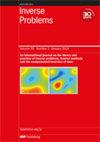Resolving full-wave through-wall transmission effects in multi-static synthetic aperture radar
IF 2.1
2区 数学
Q1 MATHEMATICS, APPLIED
引用次数: 0
Abstract
Through-wall synthetic aperture radar (SAR) imaging is of significant interest for security purposes, in particular when using multi-static SAR systems consisting of multiple distributed radar transmitters and receivers to improve resolution and the ability to recognise objects. Yet there is a significant challenge in forming focused, useful images due to multiple scattering effects through walls, whereas standard SAR imaging has an inherent single scattering assumption. This may be exacerbated with multi-static collections, since different scattering events will be observed from each angle and the data may not coherently combine well in a naive manner. To overcome this, we propose an image formation method which resolves full-wave effects through an approximately known wall or other arbitrary obstacle, which itself has some unknown ‘nuisance’ parameters that are determined as part of the reconstruction to provide well focused images. The method is more flexible and realistic than existing methods which treat a single wall as a flat layered medium, whilst being significantly computationally cheaper than full-wave methods, strongly motivated by practical considerations for through-wall SAR.解析多静态合成孔径雷达中的全波穿墙传输效应
穿墙合成孔径雷达(SAR)成像在安全领域具有重要意义,尤其是在使用由多个分布式雷达发射器和接收器组成的多静态 SAR 系统来提高分辨率和识别物体的能力时。然而,由于穿墙的多重散射效应,而标准合成孔径雷达成像具有固有的单散射假设,因此在形成聚焦、有用的图像方面存在巨大挑战。由于从每个角度都会观察到不同的散射事件,数据可能无法以天真的方式连贯组合,因此多静态采集可能会加剧这一问题。为了克服这一问题,我们提出了一种图像形成方法,通过近似已知的墙壁或其他任意障碍物来解决全波效应,这些障碍物本身有一些未知的 "干扰 "参数,这些参数将作为重建的一部分来确定,以提供聚焦良好的图像。这种方法比现有的将单面墙壁视为平面分层介质的方法更灵活、更逼真,同时计算成本也比全波方法低得多,这主要是出于对穿墙合成孔径雷达的实际考虑。
本文章由计算机程序翻译,如有差异,请以英文原文为准。
求助全文
约1分钟内获得全文
求助全文
来源期刊

Inverse Problems
数学-物理:数学物理
CiteScore
4.40
自引率
14.30%
发文量
115
审稿时长
2.3 months
期刊介绍:
An interdisciplinary journal combining mathematical and experimental papers on inverse problems with theoretical, numerical and practical approaches to their solution.
As well as applied mathematicians, physical scientists and engineers, the readership includes those working in geophysics, radar, optics, biology, acoustics, communication theory, signal processing and imaging, among others.
The emphasis is on publishing original contributions to methods of solving mathematical, physical and applied problems. To be publishable in this journal, papers must meet the highest standards of scientific quality, contain significant and original new science and should present substantial advancement in the field. Due to the broad scope of the journal, we require that authors provide sufficient introductory material to appeal to the wide readership and that articles which are not explicitly applied include a discussion of possible applications.
 求助内容:
求助内容: 应助结果提醒方式:
应助结果提醒方式:


